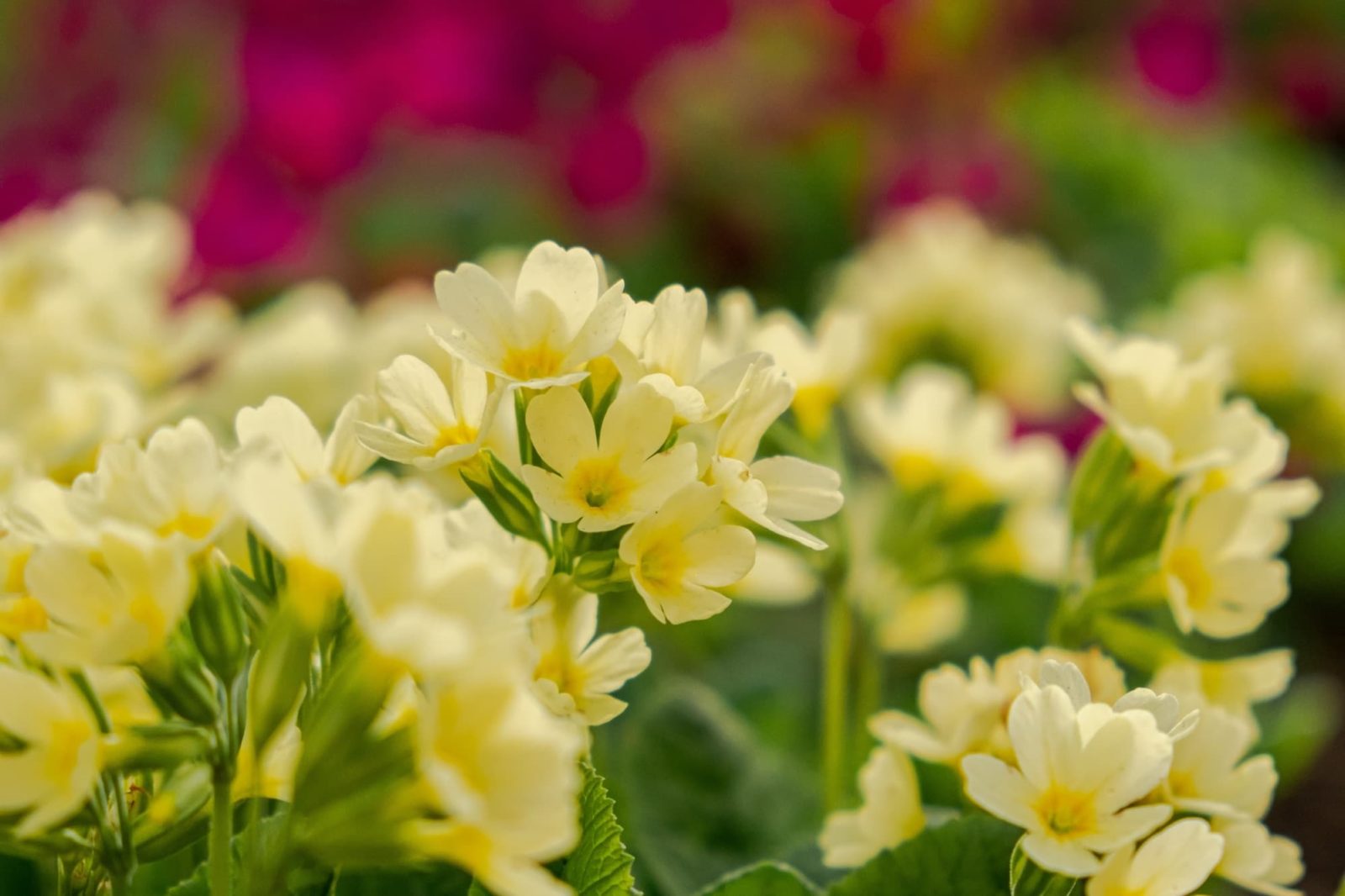PERENNIALS > PRIMROSE > VARIETIES
Reviewed By DAN ORI

Dan has over 27 years’ under his belt caring for plants and gardens. Working as a Horticultural Instructor and Consultant, he draws on a diverse range of experience that includes working as a Head Gardener, Tree Surgeon, Garden Centre Trouble Shooter, and writer of academic papers. Dan has a Level 3 Diploma in Horticulture and is currently a candidate for the RHS’s most prestigious award – The Master of Horticulture.
IN THIS GUIDE
- 1) English Primrose
- 2) Common Primrose
- 3) Sibthorp Primrose
- 4) ‘Dunbeg’ Primrose
- 5) ‘Taigetos’ Primrose
- 6) ‘Danova’ Series
- 7) ‘Charisma’ Series
- 8) Common Cowslip
- 9) Giant Cowslip
- 10) ‘Crescendo’ Primrose
- 11) ‘Francisca’ Primrose
- 12) ‘Guinevere’ Primrose
- 13) Mountain Cowslip
- 14) ‘Aire Mist’ Primrose
- 15) Primula ‘Broadwell Milkmaid’
- 16) Primrose ‘Clarence Eliot’
- 17) Garden Auricula
- 18) True Oxlip
- Honourable Mentions
PRIMROSE GUIDES
Growing From Seed
Varieties
Both the English Primrose and the Common Primrose are so well-known and are such standard bearers for their genus that have lent their name to a colour – the soft, pale tone of yellow commonly called ‘Primrose’ on paint cans and swatches around the world.
This being the case perhaps it is somewhat surprising that Primroses come in an astonishing variety of shades and hues, and even a few edged and striped varieties.
Most of these flowers are showy, and many are fragrant and pull butterflies and bees.

Another recognisable visible property of Primula is that many plants of this genus form a basal rosette of stemless leaves.
Most Primula varieties’ leaves themselves are very distinct, being deep but bright green, rather crinkled, and having a dentate margin.
Another distinctive feature is that many varieties’ flower stalks are somewhat hairy.
Plants of heights from 15 to 30 centimetres and a clumping habit are seen very frequently.
Here are eighteen of my favourites, along with some notable mentions I couldn’t help but include at the end:
1) English Primrose

- BOTANICAL NAME: P. vulgaris or P. acaulis
- TYPE: Common Primrose
- HARDINESS RATING: H7
- FLOWER COLOUR: Varies
The ‘mother species’, so to speak, grows only up to 10cm with a similar spread.
The leaves are tongue-shaped and of a medium green hue.
The open, salver-shaped flowers of 2.5-3.5cm are soft, pale yellow with a bright buttercup yellow eye.
A mutation has resulted in some plants bearing pink or purplish flowers of the same soft, pale tone as the standard yellow ones, and also whitish ones.

Flowers bloom in spring and have a scent whose soothing gentleness matches that of their colour.
While the English Primrose is on the decline in East Anglia, it continues to thrive in the South-Western region, particularly Devon County.
It is native to Europe but its population is declining all over Europe except in the United Kingdom.

These plants prefer a sheltered spot, in moist but well-drained soil, and are fully hardy, with a H7 hardiness rating.
Whether in a woodland garden, cottage garden or wildflower meadow, these lovely spring blooms work extremely well in many different gardens.
This plant has received the RHS Award of Garden Merit.
2) Common Primrose
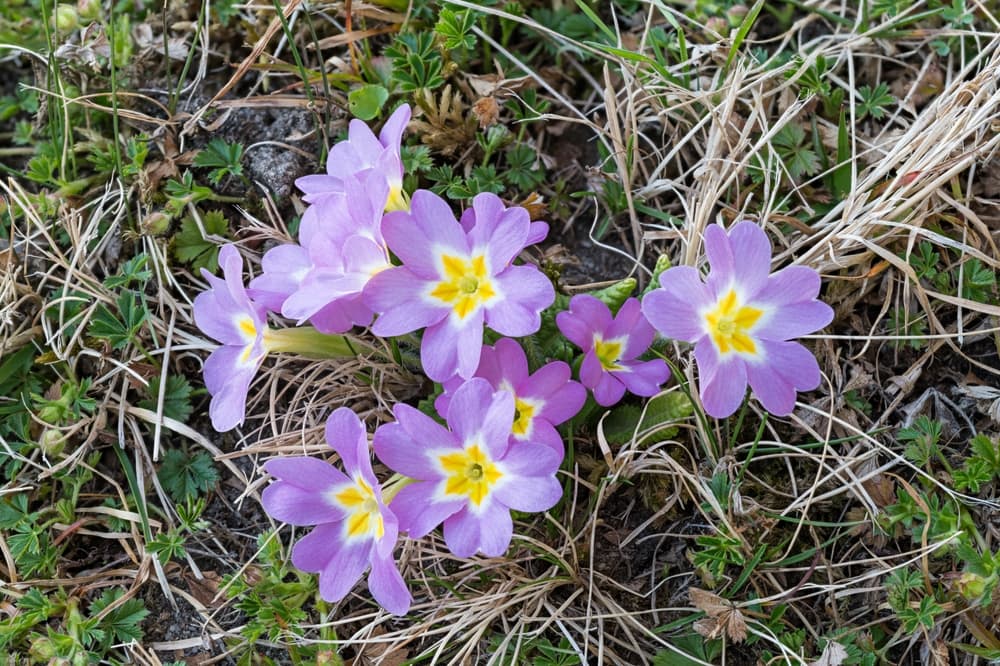
- BOTANICAL NAME: P. vulgaris subsp. vulgaris
- TYPE: Common Primrose
- HARDINESS RATING: H7
- FLOWER COLOUR: Varies
The frequently-seen subspecies of the English Primrose differs from the species in being 20-40cm tall and with a similar spread.
The flowers, while similar and also scented, are also a little bigger.
Finally, it starts to bloom a little earlier than the English Primrose, often in late winter.
Even its range is bigger, covering most of Europe and extending to Southwestern Asia and the Northwestern sliver of Africa but this variety too is dwindling throughout its range except for the United Kingdom.
Recipient of the RHS Award of Garden Merit.
“The English primrose and common primrose are derived from the same species Primula vulgaris, with ‘vulgaris’ meaning common in Latin,” shares Master Horticulturist Dan Ori.
“Depending on where you are from and who taught you, you may call both species the common primrose.”
3) Sibthorp Primrose
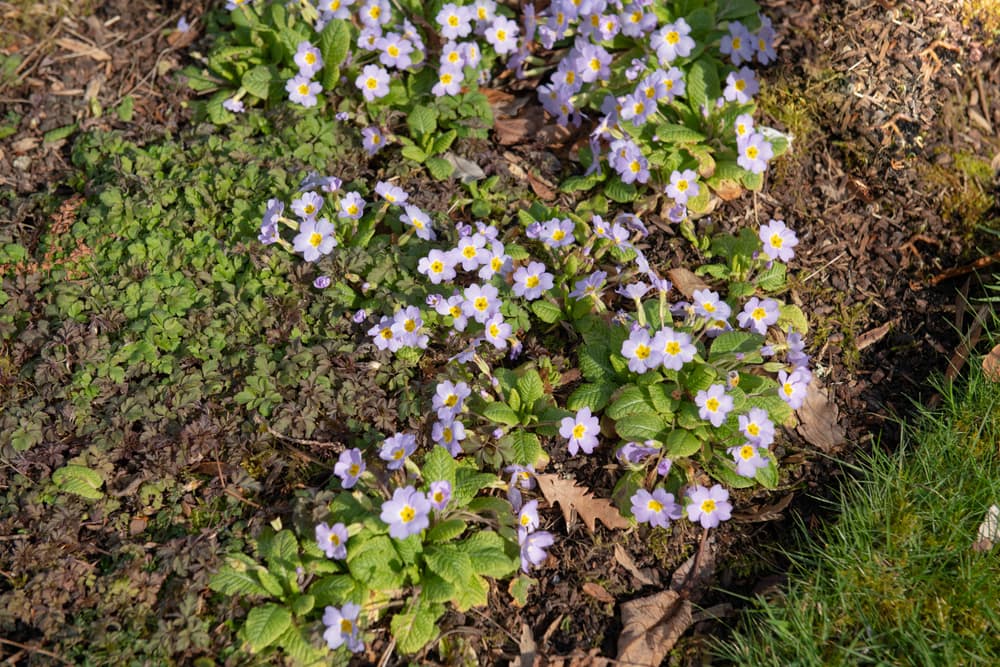
- BOTANICAL NAME: P. vulgaris subsp. sibthorpii
- TYPE: Common Primrose
- HARDINESS RATING: H5
- FLOWER COLOUR: Varies
Another subspecies of P. vulgaris, it is 20-40cm tall but with a spread of about 10cm.
It has clusters of long-stalked flowers which are a lovely vibrant pinkish purple colour.
These flowers are around 2-3cm wide, and also bloom in early spring.
They can also work well in full sun or partial shade and are H5 hardy.
Blooming in spring, it is found in a swath of land from Greece to Turkey.
Another recipient of the RHS Award of Garden Merit.
4) ‘Dunbeg’ Primrose

- BOTANICAL NAME: P. vulgaris ‘Dunbeg’
- TYPE: Common Primrose
- HARDINESS RATING: H7
- FLOWER COLOUR: White and Yellow
This variant is similar to P. vulgaris with the difference that its foliage is a bronzed green with an ochreous tinge and the flowers being off-white or even pure white with a brilliant, deep yellow centre.
5) ‘Taigetos’ Primrose

- BOTANICAL NAME: P. vulgaris ‘Taigetos’
- TYPE: Common Primrose
- HARDINESS RATING: H7
- FLOWER COLOUR: White and Yellow
This cultivar of P. vulgaris is also around 15cm tall, and yet its flowers are white, with yellow centres.
The white blooms really stand out in dappled shade and bring some light into these somewhat shadier spots in the early spring.
Just like the typical P. vulgaris, they can grow in sun or partial shade, in moist but well-drained soil. And they are H7 hardy.
6) ‘Danova’ Series

- BOTANICAL NAME: Primula ‘Danova’ Series
- TYPE: Common Primrose
- HARDINESS RATING: H5
- FLOWER COLOUR: Varies
The AGM-winning ‘Danova’ series of primroses are a range of clump-forming plants which have attractive flowers with large yellow eyes and petals in numerous shades, from cream, to yellow, to pink, to red, to purple.
This species offers near-year-round blooms in over 35 hues and shades.
They bloom from late winter and into early spring and sit within the primrose group of Primulas.
They are H5 hardy and will grow well in a range of environments in full sun or partial shade, in moist but well-drained soil.
They do best in a loam or sand with neutral or acidic pH.
7) ‘Charisma’ Series
- BOTANICAL NAME: Primula ‘Charisma’ Series
- TYPE: Common Primrose
- HARDINESS RATING: H5
- FLOWER COLOUR: Pink, Purple and Yellow
Another AGM awarded group of primroses is the ‘Charisma’ Series.
These perennials grow around 20cm tall and they have vibrant pink flowers which are strongly flushed with a deeper reddish-purple, centred on bright yellow eyes.
Under glass, they flower from the late winter.
These are also H5 hardy, and also prefer a moist but well-drained, acidic or neutral loam or sand.
They can grow well in full sun or partial shade, but should not be allowed to dry out in hot weather.
These can be a great choice for container growing in particular, in an east-facing or south-facing spot.
8) Common Cowslip

- BOTANICAL NAME: P. veris
- TYPE: Cowslip
- HARDINESS RATING: H5
- FLOWER COLOUR: Yellow
The Cowslip plant has a basal rosette of leaves on short stalks over which a main stem rises to 20-30cm.
It bears an umbel of small, 1.5cm bell-shaped flowers that are strongly scented and are of a deep, brilliant yellow hue.
It is native to the United Kingdom, much of Europe and Western Asia.
These are a great choice for a sheltered position in a bed, container or meadow scheme, in full sun or partial shade, with moist but well-drained soil.
It blooms in mid and late spring. RHS Award of Garden Merit.
9) Giant Cowslip
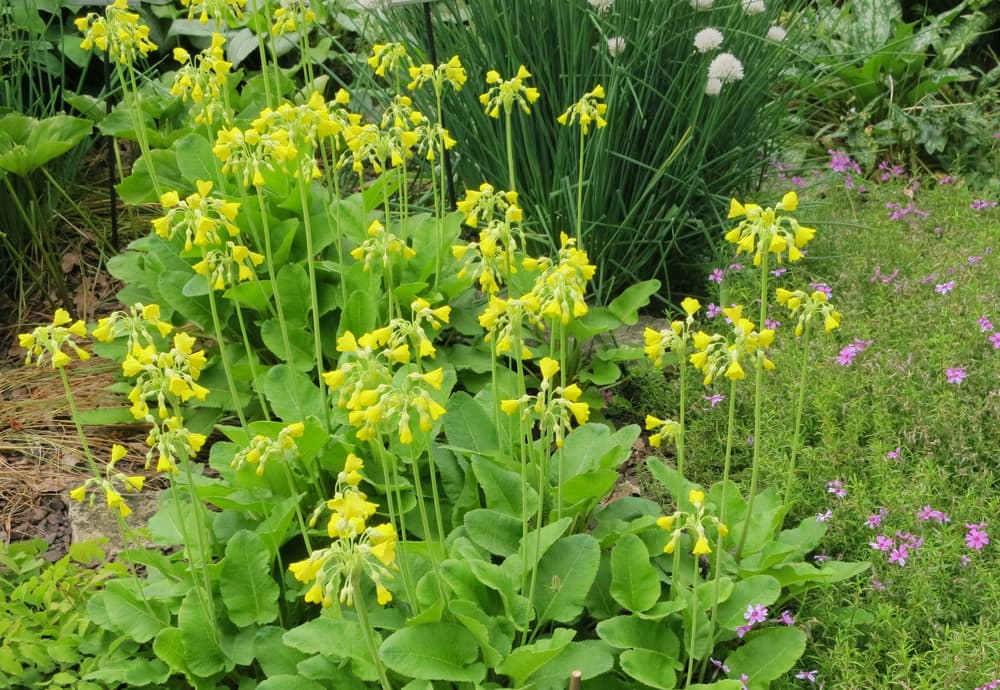
- BOTANICAL NAME: P. florindae
- TYPE: Cowslip
- HARDINESS RATING: H7
- FLOWER COLOUR: Yellow
Much bigger than its diminutive namesake, this native of Tibet reaches a height of 1.2m.
The large leaves are 20-40cm long and even the stems are noticeably thicker.
The flowers are a much bigger version of those borne by P. veris and are similarly coloured.
However, they are more profuse, being 20-30 per umbel, and are even more strongly and sweetly scented.
It blooms through the summer – has received the RHS Award of Garden Merit.
10) ‘Crescendo’ Primrose
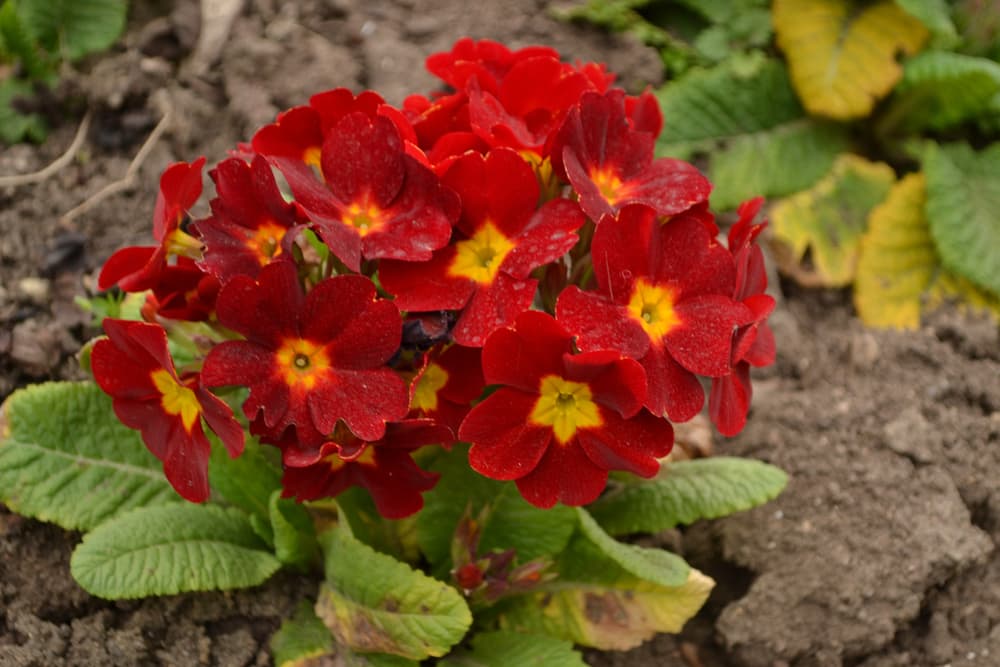
- BOTANICAL NAME: Primula ‘Crescendo’ Series
- TYPE: Polyanthus
- HARDINESS RATING: H5
- FLOWER COLOUR: Pink, Red, Blue & More
The Polyanthus group of Primulas are perennials often grown as biennials.
They form rosettes, and bear umbels of salver-shaped blooms in the winter and spring.
The ‘Crescendo’ Series offers several options which have been given an Award of Garden Merit: Pink and Rose Shades, Bright Red, and Blue.
These names refer to the colour of the petals arrayed around the vivid yellow eyes.
These Polyanthus are H5 hardy, they like full sun or partial shade, and moist but well-drained soil which is acidic or neutral.
11) ‘Francisca’ Primrose
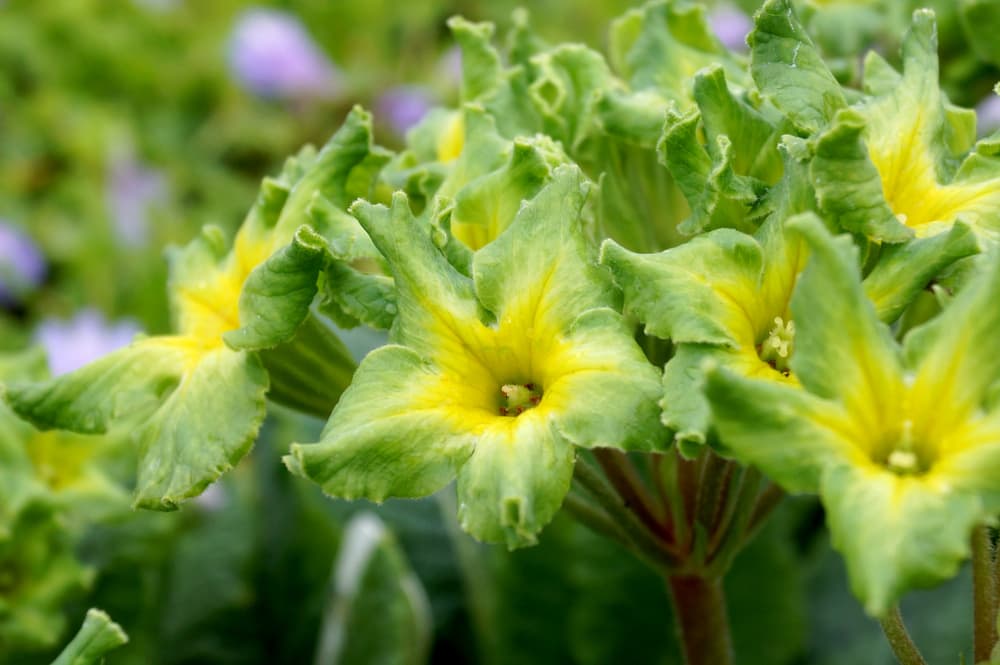
- BOTANICAL NAME: Primula ‘Francisca’
- TYPE: Polyanthus
- HARDINESS RATING: H7
- FLOWER COLOUR: Yellow And Green
This is an evergreen perennial that grows around 18cm tall – it has unusual green, yellow-eyed flowers which are 3-4cm across.
The petals have a slightly ruffled appearance and look almost like leaves.
With excellent weather resistance, this Polyanthus will bloom throughout spring and summer.
This option is H7 hardy, good for sun or part shade.
It likes a moist but well-drained, acidic or neutral soil but will not do well if allowed to dry out too much in hot weather.
12) ‘Guinevere’ Primrose

- BOTANICAL NAME: Primula ‘Guinevere’
- TYPE: Polyanthus
- HARDINESS RATING: H6
- FLOWER COLOUR: Pink And Purple
This Polyanthus is semi-evergreen perennial which grows to around 12cm tall.
It has purplish-bronze leaves, and bears umbels of very pale pinkish purple, yellow-eyed flowers 3-4cm across in the spring.
It is H6 hardy, and also likes sun or partial shade.
The soil, which can be of any type and pH, should be moist but well drained.
13) Mountain Cowslip
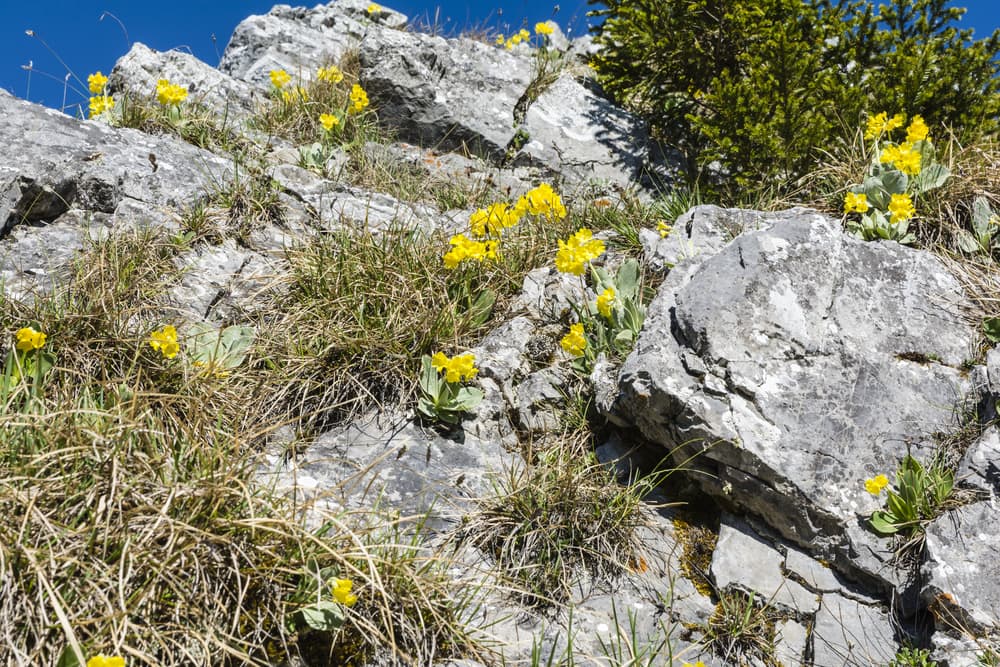
- BOTANICAL NAME: P. auricula
- TYPE: Auricula
- HARDINESS RATING: H5
- FLOWER COLOUR: Yellow, Pink And Purple
Auricula Primulas are evergreen perennials with leathery foliage and simple umbels of salver-shaped flowers which are usually pink, purple or yellow.
This option has fragrant, bright yellow flowers 1-2.5cm across, which form in umbels on stems 20cm tall in the spring.
H5 hardy, for any moist but well drained soil in full sun or partial shade.
It can also be grown in pots in an alpine house.
14) ‘Aire Mist’ Primrose

- BOTANICAL NAME: Primula ‘Aire Mist’
- TYPE: Auricula
- HARDINESS RATING: H5
- FLOWER COLOUR: White
This Auricula is a small perennial 10cm tall, with pure white flowers which rise on short stems in the spring.
This will grow best in a well drained, alkaline soil and could be a good choice for an alpine house or rock garden.
15) Primula ‘Broadwell Milkmaid’
- BOTANICAL NAME: Primula ‘Broadwell Milkmaid’
- TYPE: Auricula
- HARDINESS RATING: H5
- FLOWER COLOUR: White
The flowers of this Auricula can bloom so profusely that they entirely cover the leaves; they are a milky white colour.
These are best grown in an alpine house or frame, in a loam-based compost with added lime.
Avoid wetting the foliage and flowers.
16) Primrose ‘Clarence Eliot’

- BOTANICAL NAME: Primula ‘Clarence Eliot’
- TYPE: Auricula
- HARDINESS RATING: H5
- FLOWER COLOUR: Lilac
This Auricula grows around 10cm tall.
It has lilac-mauve coloured blooms, with white throats, that grow on short stems above the foliage in spring.
H5 hardy; best grown in an alkaline, well-drained medium in a rock garden or alpine house.
17) Garden Auricula

- BOTANICAL NAME: P. x pubescens
- TYPE: Auricula
- HARDINESS RATING: H5
- FLOWER COLOUR: Purple, Pink, Red, Yellow And White
Garden auricula is an evergreen perennial to 12cm.
The often fragrant flowers bloom in a range of different hues, from purple, to pink, to red, to yellow, to white.
They are around 2cm across, often with prominent eyes.
18) True Oxlip
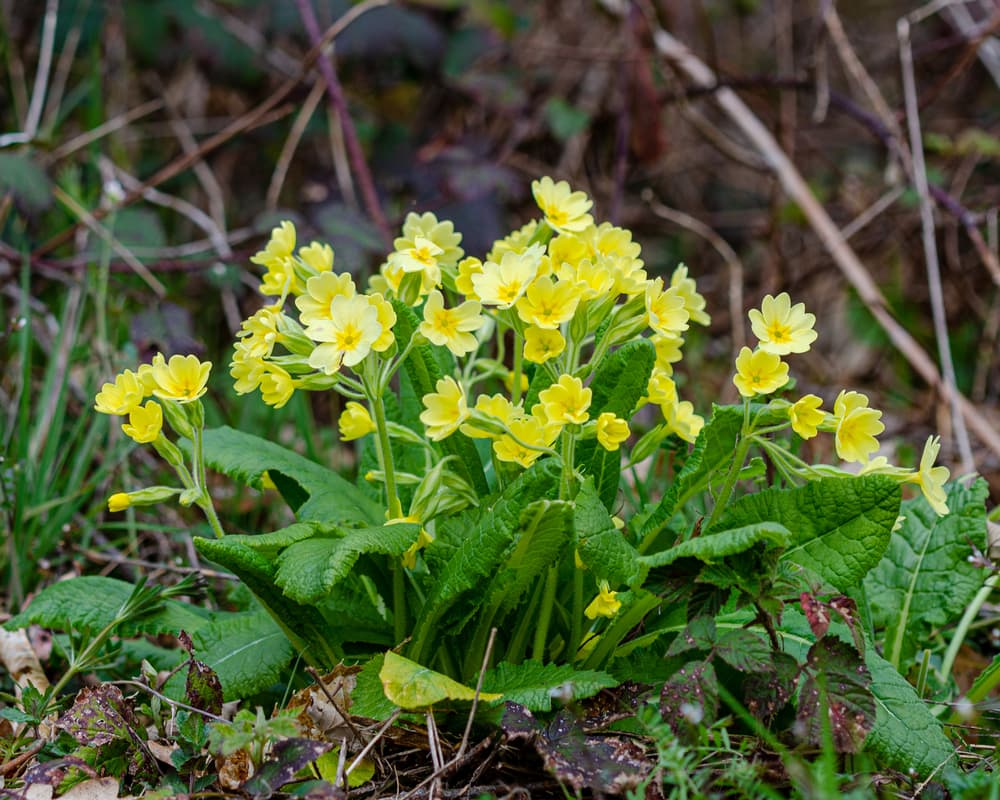
- BOTANICAL NAME: P. elatior
- TYPE: Oxlip
- HARDINESS RATING: H6
- FLOWER COLOUR: Yellow
Another UK native, the oxlip is another semi-evergreen perennial.
It grows around 30cm tall and bears dark-eyed yellow flowers, 2.5cm across, in one-sided clusters on its erect stems.
This is another great wildlife-friendly choice for your garden – great in containers, in beds or borders, or in a wildflower meadow in full sun or partial shade, in moist but well-drained soil.
H6 hardy.
Honourable Mentions
Other species, less commonly found in British gardens, include:
P. parryi or Parry’s Primrose

A non-native species from ‘the New World’.
P. malacoides or the ‘Fairy Primrose’

From clear across the planet – the Indochina region.
Notable and very pretty species from Japan and the Far-East include:
P. japonica or ‘Apple Blossom Primrose’

P. sieboldii or the ‘Cherry Blossom Primrose’

P. sieboldii extensively has been cultivated in Japan and a number of stunning cultivars have been developed.
P. denticulata
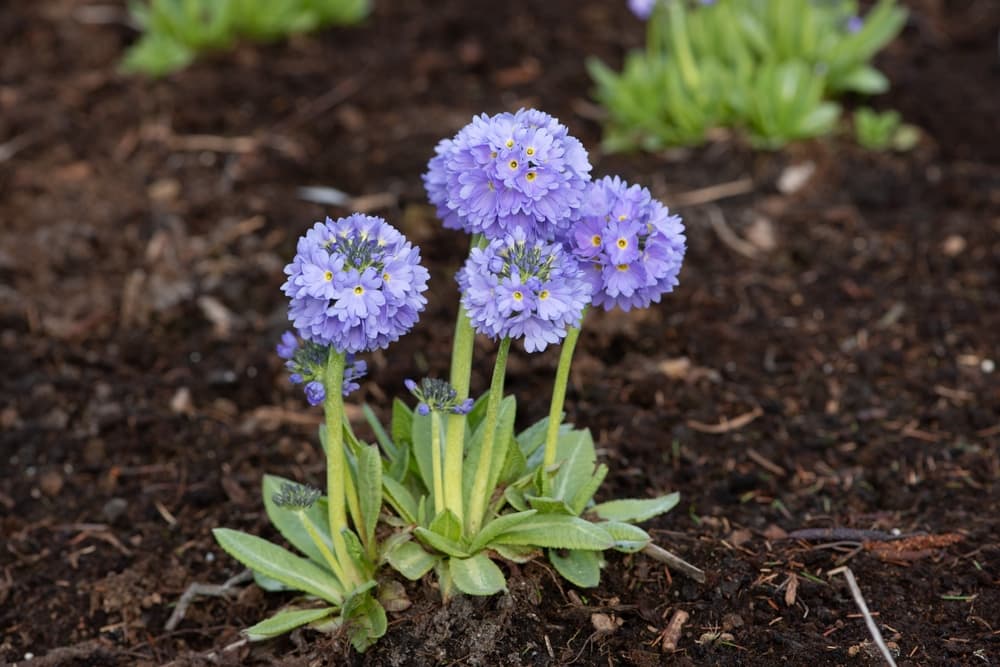
As for the unusual P. denticulata, its colloquial name, ‘Drumstick Primula’, is surely the more descriptive on account of its unusual ‘drumstick’ flowers.
P. ‘Inverewe’
There is yet another such primrose, Primula ‘Inverewe’ or Candelabra Primrose which bears its vermilion flowers in a whorl not dissimilar from a candelabra.
‘Belarina’ Series
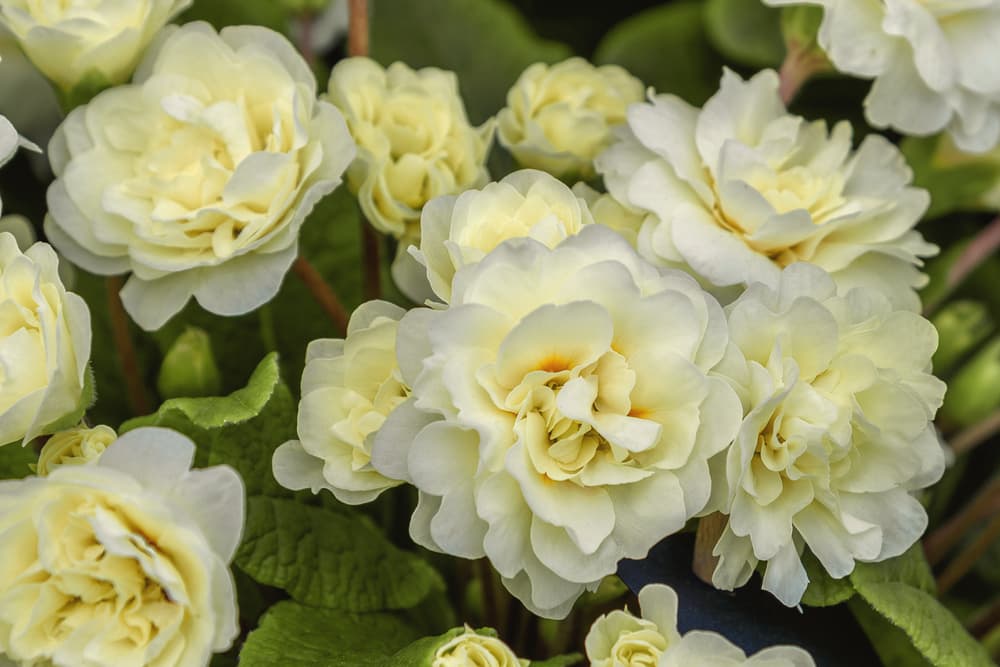
The lesser-known ‘Belarina’ Series features unusual double form in rich, saturated hues.
This next variety produces eye-catching ‘standard’ flowers but of similar rich, saturated hues:
P. ‘Perle Von Bottrop’

This variety has a creeping habit with magenta-purple flowers.
We close with three highly unusual varieties:
P. vialii

With flowers strongly resembling those of the Southern African Kniphofia or ‘Red Hot Poker’ is P. vialii AKA ‘Red Hot Poker Primrose’!
The flower is essentially a ‘hair curler’ of lilac from which emerges a central tip of ruby red.
P. ‘Gold Laced’ Group

P. ‘Gold Laced’ Group, one of the Polyanthus Primroses, presents stunning saucer-shaped flowers that are startling crimson-to-black with a broad golden central disk and golden edging.
P. ‘Zebra Blue’

Another Polyanthus is P. ‘Zebra Blue’ and it is true to its name as the stunning flower displays delicate blue-and-white striping and veining.
Of course, these are just a small fraction of the many, many primroses and other Primulas that you might grow in a UK garden.

